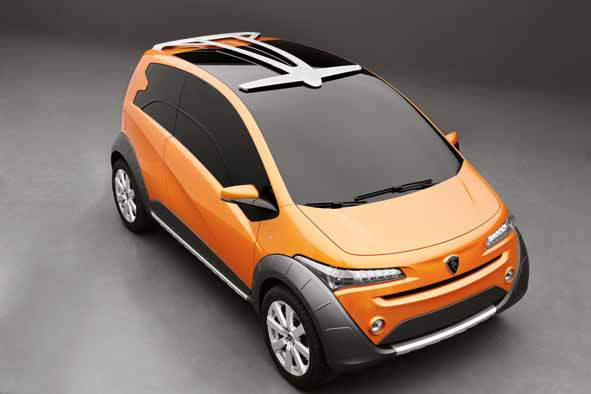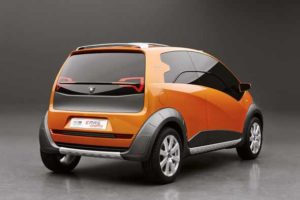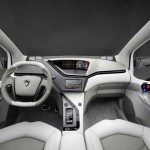Italdesign Giugiaro REVOLUTIONISES TRADITIONAL MARKET SEGMENTATION WITH EMAS

Moncalieri (TO)
At the eightieth edition of the Geneva International Motor show (4-14 March 2010), Italdesign Giugiaro is introducing Emas, a family of low environmental impact cars that is set to revolutionise traditional segmentation in the car market.
The design, created with the Malaysian manufacturer PROTON is based on a plug-in hybrid drive system designed with Lotus Engineering and was developed with the aim of optimising the available on-board space and car access ergonomics.
“We have created a family of models in different configurations but all offering the passenger room of a medium-category car while maintaining the exterior dimensions of a compact mini. The architecture has been designed in such a way as to allow us to outfit an infinite number of variants without compromising the car's great comfort and extensive interior space” explained Giorgetto Giugiaro, Chairman of Italdesign Giugiaro.


The name, Emas, meaning “gold” in Malay, is the acronym for Eco Mobility Advanced Solutions.
Emas: the three configurations
Italdesign Giugiaro is exhibiting three configurations of the compact car family produced with PROTON at the Geneva motor show:
Emas Comfort: hatchback saloon, five doors, four seats, length of 3550 mm, hybrid drivetrain in Comfort
Emas Country: hatchback saloon, three doors, five seats, length of 3550 mm, hybrid drivetrain in a Country
Emas3 City: hatchback saloon, three doors, 3+1 Plus seats, 3 metres in length in City outfit with plug-in electric drive
“Developing a car based on a hybrid system allows the designer to maximise all the opportunities and advantages offered by the combination of engines, motors (internal combustion and electric) and batteries in terms of box and bulk arrangement” continued Giugiaro.
Homage to Rudolf Hruska
When approaching the design of a compact, functional car family, Giugiaro called on his valuable years of collaboration with Rudolf Hruska, who was hired by Alfa Romeo to bring the Alfasud product range and factory into being.
Hruska (Vienna 2 July 1914, Turin 4 December 1995) was a legendary Austrian engineer who worked for Ferdinand Porsche and then for Cisitalia, Alfa Romeo and Fiat-SIMCA before returning to Alfa. In 1967, he chose Giorgetto Giugiaro to design the Alfasud range.
Italdesign was set up in February 1968 to develop the entire Alfasud project, including design and development of the product and the new Pomigliano d’Arco factory.
“Hruska taught me a rigorous approach to automotive design with the emphasis on function and industrial feasibility. This strategy forces the creative designer to seek good-looking solutions that fit in with the engineering layout rather than coming up with shapes that mean that engineering compromises have to be made”, reminisced Giugiaro.
“You could say that the product developed with PROTON is a brand new type of car, a new automotive concept where looks – in line with Hruska's teaching - are as important as function, ergonomics and comfort, not to mention environmental impact”, continued Giugiaro.
A compact car with the passenger room of an SUV
“With this project, we have shown that the car layout can remain unchanged irrespective of the type of fuel system; be it conventional, hybrid with petrol engine, hybrid with natural gas engine or fully electric”.
The platform, specially designed by Italdesign Giugiaro for this car family, includes a raised floorpan that is able to accommodate the hybrid or electric system batteries in the centre. The raised position of the seats, all electrically adjustable, allows passengers to make the best possible use of the interior space.
The combination of these two design features makes the actions of getting into and out of the car very user-friendly, particularly at the rear. The levels of convenience are comparable only to those of a few other higher-category cars.
The seat H point (corresponding to the passenger hip position) is located higher than that of mass-produced cars but lower than that of an SUV.
“This is the outcome of several years of study: the solution allows interior roominess on a par with that of a segment D saloon despite maintaining the exterior dimensions of a segment A car”, explained Giorgetto Giugiaro.
“These new PROTON cars are higher than other compact car models to make the best use of interior space; the seat H point is at the same height as the passengers' hips: you do not get down into your car as in a coupé, you do not climb up as in an SUV but you enter in a natural way. Rear seat comfort when you enter and leave the car is absolutely unprecedented, the distance from the front seat is comparable to that of an SUV”, added Giugiaro.
The five door version packs a 320 litre luggage compartment able to house two medium-sized suitcases with ease into a length of just 3550 mm.
Present and future of the Emas family, the compact cars developed by Italdesign Giugiaro with PROTON
The forerunner of the Emas family is a five door hatchback with the emphasis on Comfort, because the rear seats are the same as the front seats to create four business class seats within just 3550 mm of total length.
The front-end features the PROTON Shield housed in a longitudinal slot below the bonnet. This also incorporates the light clusters and is enhanced by two distinctive diamond-shaped fog lights. The engine cooling air intake, located between the fog lights, is concealed within a dark grey trapezoid motif. Its size varies according to the type of engine installed, without altering the look of the front-end.
The side is dominated by a belt line that drops down decisively toward the windscreen pillar to increase side visibility during parking manoeuvres. The side is enlivened by a sculpted shape, enhanced by a rib that runs from the front wheel arch then swoops up toward the rear.
The large wheel arches are perhaps the most distinctive and substantial aspect of the car body; the wheelbase is generous: 2590 mm for a total length of 3550 mm. The wheels are therefore located at the end of the Emas: this gives the impression of a car much bigger than it actually is.
The B pillar is painted black to create the sensation of visual continuity with the side windows, while the C pillar features a motif based on an “E”, the initial letter of Emas.
Oceans of glass allow plenty of light into the interior. Only the lower part of the side windows – the part you actually need to open to pay tolls or car parks – is mobile in order to keep the window opening system simpler and lighter.
The windscreen extends along three quarters of the roof to create a sky-dome effect that dominates the view from above. Protective sun blinds are housed in the central crossmember and extend longitudinally toward both the front and rear seats.
The rear view is dominated by a generous rear window incorporating all the tail-lights, which are entirely based on LED technology. These are located beneath the glass and are invisible when the car is turned off. A subtle lip joins both light clusters and surrounds the reversing lights and direction indicators. When the tailgate is open, the lights are replicated by two supplementary tail-lights located in the lower part of the bumpers on either side of the rear air intake.
The Country interpretation portrays the Emas as an urban SUV, keeping to the length of 3550 mm but switching to a three-door architecture.
Access to the car is still easy due to generous doors measuring no less than 1350 mm in length and the ergonomic and rational position of the rear seats, that are set 120 mm further forward than in the five-door version.
In particular, the amount of passenger room rises from 4 to 5 seats by replacing the two independent rear seats with a sliding three-seater bench seat. This means that the amount of foot room for passengers in the rear can be adjusted according to requirements.
The bench seat can also be folded completely flat to increase the load volume: this boosts the luggage space from 390 to approximately 780 litres.
A few telling touches create a distinctive off-road exterior look: wheel arches, side-sill perimeter base, bumpers toughened by radial ribbing and the lower part of the tailgate are highlighted by a bronze metallic finish. The roof features a rollbar/roof-rack.
The front-end differs from the urban, five-door version due to its more aggressive look: the PROTON shield is now fitted at the top of a grille surmounting a large longitudinal air intake. The two fog lights are round and sunk into the body.
The lower part of the front and rear bumpers and the side-sills are toughened by metal inserts.
Emas3 is the City interpretation: the five-door configuration has been left unchanged while the architecture has undergone drastic changes to reduce the wheelbase by 550 mm to contain the total length within just 3 metres.
The doors used are the same as on the Country version, 1350 mm and allowing easy access, even to rear seat passengers.
The front-end emphasises the different outfit: unlike its big sister, the fog lights are trapezoid in shape and joined by a large rectangular air intake.
The tailgate, produced specifically for this version, is more upright in order to ensure plenty of passenger headroom and acceptable load capacity despite the compact exterior.
The passenger room drops to 3+1 Plus seats. The passenger seated behind the driver has less leg-room but there is still enough space even for an adult.
Depending on the number of batteries chosen to increase the range of this version, devised with solely plug-in electric traction, the passenger room could drop to three or two seats if necessary, with a large luggage compartment.
In addition to the three interpretations on show in Geneva, Italdesign Giugiaro has also come up with other possible permutations of the Emas family developed with PROTON, including:
• Coupé Comfort: slightly more raked windscreen and low roof for a sporty interpretation.
• Coupé Sport: even more steeply raked windscreen to accentuate the sportiness, underscored by a special door and longer front and rear overhangs.
• Country Cabrio: the Country version loses its roof to become a four-seater cabriolet.
• Compact Wagon: the Comfort version with longer rear overhang to increase the load space and become a compact station wagon. Both five-door and three-door versions are envisaged, the latter could come with panels instead of the rear side windows for commercial use.
• H-van: identical to the five door version to the front door and then complemented by a generous load compartment that is extended by a high top to the windscreen and a lengthened rear overhang.
A glance at the interiors
The first aspect that strikes you, even before you discover the car interiors, is the door handle: an ergonomic design that incorporates a set of secondary controls that vary from place to place.
The driver can use the handle grip to control all four power windows, door locking and unlocking, the courtesy lights, side mirror adjustment and electrical lowering of the rear head restraint to improve visibility while reversing.
The front passenger can also adjust the hi-fi system as well as his or her own window. The rear passengers can also adjust their seats from the handle grip.
Two TFT panels dominate the dashboard. They are housed side by side in the centre of the dashboard, at a concave angle.
The right-hand monitor shows the speedometer and the main car operating indicators in addition to hybrid system energy flows.
The left-hand monitor shows secondary information such as screens for the hi-fi system, telephone and internet access browser plus personalised car set-up parameters.
A third display, located beneath the central console, is a touch screen that controls all the car's main and secondary functions. The right part of this TFT screen permanently displays the climate system temperature and air flows.
The lower part of the central console, housing the ignition button and gear selector, extends towards the tunnel and can be folded down. When parking in a tight spot, forcing the driver or front passenger to leave the car from the opposite side, this central element can be lowered and the seat moved back so that they can get out on the other side without hindrance.
The central console also houses two USB ports to connect digital music players and mobile phones, plus an SD card slot for satellite navigation maps.
The central part houses a dock specially designed for the Apple iPhone. This dock is interchangeable and can house other phone and smartphone models. It can recharge the phones and connect them automatically to the car without the need to use other coupling systems.
Powered by Lotus Engineering
The drive system is a series hybrid plug-in developed by Lotus Engineering, a Proton Group company. It includes a 3 cylinder 1.2 litre internal combustion engine developing 51 horsepower (38 kW) at 3500 rpm that can run on petrol, ethanol, or methanol.
The front transverse internal combustion engine is coupled to a generator and serves exclusively to recharge the 11.5 kWh capacity lithium ion batteries.
rive is assured by an electric motor with continuous power of 45 kW and 75 kW peak power.
The high maximum torque, 240 Nm, does not require the use of a gearbox.
Acceleration 0-100 km/h takes place in 14 seconds, top speed is 170 km/h and battery range in the hybrid configuration is 50 km. Full recharging of the battery pack takes three hours using a traditional 240-volt outlet.
The performance and range of the City three door electric plug-in version are currently being assessed.
Technical specifications
Dimensions and weights
Length (mm)
3555-3000
Height (mm)
1576
Width
1699
Wheelbase (mm)
2590-2035
Front tyres
215/45 R18
Rear tyres
215/45 R18
Front rims
18”
Rear rims
18”
Boot capacity
320-390 litres
Mechanical units and performance
Mechanical architecture
hybrid, series, plug-in
Internal combustion engine position
front transverse
Technical specifications
3 cylinders in line, 6 valves, 1.2 litres
Power
51 hp / 38 kW at 3500 rpm
Maximum torque
107 Nm at 2500 rpm
Electric motor position
rear
Power
75 kW (peak), 45 kW (continuous)
Maximum torque
240 Nm
Batteries
100 X 31 Ahr Cells
370 Volts
11.47 kWh
Time for full recharge
3 hours with normal 240 Volt, 13A power point
Acceleration 0 - 100 km/h
14 sec
Top speed
170 km/h (peak), 130 km/h (continuous)
Range in electric mode
50 km
Traction
rear
One-speed gearbox
final drive ratio 4.214:1
Front suspension
McPherson
Rear suspension
torsion beam
Throughout the Geneva Motor Show, you can follow Italdesign Giugiaro's participation on the website www.italdesign.it, which has been fully revised and entirely dedicated to the event.
ABOUT ITALDESIGN GIUGIARO
The roots of the Italdesign Giugiaro Group go back to 1968 when Giorgetto Giugiaro set up a design studio that represented an innovative formula for the car industry and its mission has remained unchanged throughout the intervening 43 years: a firm set up to act as an independent service company, with the aim of delivering creativity, engineering, construction of preseries prototypes, production start-up assistance and all the support required to put a new product into production. Giorgetto Giugiaro heads the company as its Chairman together with his son Fabrizio, Deputy Chairman and Manager of the Style Centre.
Since 1968, some 200 car models have been created that have spawned 50 million standard production units produced by leading international car manufacturers.
Further information is available on the website www.italdesign.it
ABOUT PROTON
PROTON was set up in 1983 and is the biggest car manufacturer in Malaysia. It is present in key markets, from the United Kingdom to the Middle East, South East Asia and Australasia. Its activities include vehicle engineering, research and development, construction, distribution, sales, marketing and aftersales services. The company has research centres dedicated to new automotive technologies in Malaysia and the UK.
PROTON produces cars that are able to satisfy a set of consumer demands and requirements. The product range includes a versatile, reliable, four-door family vehicle, three-door hatchback versions for customers who are young at heart, deluxe saloons, roomy, economical MPVs as well as the world-renowned Lotus sports cars. For further details, visit www.proton.com
For more details on PROTON, contact Izad Raya, Head of Group Communications (amyzadr@proton.com) or Yohani Yusof, Director of Group Marketing and After Sales (yohanimy@proton.com).
ABOUT LOTUS
The main operating subsidiary of Group Lotus plc is Lotus Cars Limited, which has two operating divisions - Lotus Engineering and Lotus Cars. Lotus Engineering is an internationally recognised automotive engineering consultancy based in Norfolk, UK. Global facilities include those in Michigan (USA), Kuala Lumpur (Malaysia), China and offices in Germany and Japan.
Lotus Engineering provides comprehensive and versatile consultancy services to many of the world's OEMs and Tier 1 suppliers, offering a full engineering service from initial concept and project design through development and integration of the complete vehicle to meet all worldwide market and customer requirements to full production. This includes third party 'niche vehicle' engineering and manufacture.
Lotus Cars builds world class, prestige, high performance sports cars for sale in 37 countries. These include the iconic Lotus Elise, Exige, Europa and Lotus’ latest model, the Evora. Lotus is a global high-tech company, expanding rapidly and committed to driving forward technology for both Lotus Cars and its Engineering clients, spearheading research into such areas as hybrids, electric vehicles and renewable fuels.
















 History of "Menu dei Motori"
History of "Menu dei Motori"

 DESIGN PROJECT
DESIGN PROJECT UNIVERSITA' DI MODENA
UNIVERSITA' DI MODENA








Comments
Nessun commento presente
Add Comment